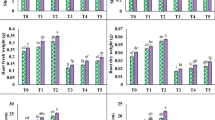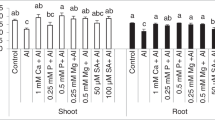Abstract—Excess amount of salt causes problem in physiological and biochemical processes of plants. In the present study, the effect of different concentrations of NaCl on physiological and biochemical changes of Vigna radiata (L.) Wilczek seedlings compared to the control plants were evaluated. Also the effect of proline-ascorbate mixture (PAM) on the alleviation of NaCl stress in the plants was assessed. In this study some physiological parameters like relative water content, shoot length, diameter of leaves; biochemical parameters like proline, protein, sugars, phenols, chlorophyll and carotenoid content along with H2O2 and superoxide anion content, catalase, peroxidase and amylase activity, ascorbate content; and sodium, potassium and calcium ion content was examined. All the physiological parameters decreased with increasing salt concentration but with PAM treatment the extent of decrease was lower. Proline content was highest in 0.2 M NaCl concentration in case of both the treatments but with PAM treatment the accumulation was much lower. Phenols, chlorophylls and protein content decreased with increasing NaCl concentration but with PAM treatment the decrease was less. Catalase and peroxidase enzyme activity increased with increasing NaCl stress but with PAM treatment their activities declined at higher concentration. Sodium, potassium and calcium ion content also increased with PAM treatment in comparison to that of the NaCl only stress. Therefore, from the present study, we could conclude that the external application of proline and ascorbate mixture overall could relieve the extent of NaCl stress as evident from the physiological and biochemical parameters studied.





Similar content being viewed by others
REFERENCES
Kumar, V., Shriram, V., Kavi, Kishor, P.B., Jawali, N., and Shitole, M.G., Enhanced proline accumulation and salt stress tolerance of transgenic indica rice by over-expressing P5CSF129A gene, Plant Biotechnol. Rep., 2010, vol. 4, pp. 37–48.
Zheng, L., Shannon, M.C., and Lesch, S.M., Timing of salinity stress affects rice growth and yield components, Agric. Water Manage., 2001, vol. 48, pp. 191–206.
Greenway, H. and Munns, R., Mechanisms of salt tolerance in nonhalophytes, Annu. Rev. Plant Physiol., 1980, vol. 31, pp. 149–190.
Bewley, J.D. and Black, M., Physiology and Biochemistry of Seeds in Relation to Germination, Springer-Verlag, 1982.
Karim, M.A., Utsunomiya, N., and Shigenaga, S., Effect of sodium chloride on germination and growth of hexaploid triticale at early seedling stage, Jpn. J. Crop Sci., 1992, vol. 61, pp. 279–228.
Acosta-Motos, J.R., Diaz-Vivancos, P., Álvarez, S., Fernández-García, N., Sánchez-Blanco, M.J. and Hernández, J.A., NaCl-induced physiological and biochemical adaptative mechanism in the ornamental Myrtus cummunis L. plants, J. Plant Physiol., 2015, vol. 183, pp. 41–51.
Hasegawa, P.M., Bressan, R.A., Zhu, J.K., and Bohnert, H.J., Plant cellular and molecular responses to high salinity, Annu. Rev. Plant Physiol. Plant Mol Biol., 2000, vol. 51, pp. 463–499.
Szabados, L., Kovacs, H., Zilberstein, A., and Bouchereau, A., Plants in extreme environments: Importance of protective compounds in stress tolerance, Adv. Bot. Res., 2011, vol. 57, pp. 105–150.
Foyer, C.H. and Noctor, G., Ascorbate and glutathione: The heart of the redox hub, Plant Physiol., 2011, vol. 155, pp. 2–18.
Smirnoff, N., Ascorbic acid: Metabolism and functions of a multifaceted molecule, Curr. Opin. Plant Biol., 2000, vol. 3, pp. 229–235.
Buettner, G.R. and Jurkiewicz, B.A., Ascorbate free radical as a marker of oxidative stress: An EPR study, Free Radical Biol. Med., 1993, vol. 14, pp. 49–55.
Ashraf, M. and Foolad, M.R., Roles of glycine betaine and proline in improving plant abiotic stress resistance, Environ. Exp. Bot., 2007, vol. 59, pp. 206–216.
Yang, S.L., Lan, S.S., and Gong, M., Hydrogen peroxide-induced proline and metabolic pathway of its accumulation in maize seedlings, J. Plant Physiol., 2009, vol. 166, pp. 1694–1699.
Molazem, D., Qurbanov, E.M., and Dunyamaliyev, S.A., Role of proline, Na and chlorophyll content in salt tolerance of corn (Zea mays L.), Am.-Eurasian J. Agric. Environ. Sci., 2010, vol. 9, pp. 319–324.
Ali, Q., Ashraf, M., and Athar, H.U.R., Exogenously applied proline at different growth stages enhances growth of two maize cultivars grown under water deficit conditions, Pak. J. Bot., 2007, vol. 39, pp. 1133–1144.
Khattab, E.A. and Afifi, M.H., Effect of proline and glycinebetain on canola plants grown under salinity stress condition, Mod. J. Appl. Biol. Sci. Crop Sci., 2009, vol. 3, pp. 42–51.
Nounjan, N. and Theerakulpisut, P., Effects of exogenous proline and trehalose on physiological responses in rice seedlings during salt-stress and after recovery, Plant Soil Environ., 2012, vol. 58, pp. 309–315.
Munns, R. and Tester, M., Mechanisms of salinity tolerance, Annu. Rev. Plant Biol., 2008, vol. 59, pp. 651–681.
Ashraf, M.Y., Roohi, M., Iqbal, Z., Ashraf, M., Ozturk, M., and Gucel, S., Cadmium (Cd) and Lead (Pb) induced inhibition in growth, some biochemical attributes and mineral accumulation in two cultivars of mung bean [Vigna radiata (L.) Wilczek], Commun. Soil Sci. Plant, 2016, vol. 47, pp. 405–413.
Barr, H.D. and Weatherly, P.E., A re-examination of the relative turgidity technique for estimating water deficit in leaves, Aust. J. Biol. Sci., 1962, vol. 15, pp. 413–428.
Bates, L.S., Waldren, R.P., and Teare, I.D., Rapid determination of free proline for water stress studies, Plant Soil, 1973, vol. 39, pp. 205–207.
Harbone, J.B., Physiochemical Methods: A Guide to Modern Techniques of Plant Analysis, Chapman and Hall Ltd., London, 1973, pp. 222–242.
Plummer, D.T., An Introduction to Practical Biochemistry, London: McGraw-Hill Book Company (U.K.) Ltd., 1978, 2nd. ed., vol. 6, p. 362.
Mahadevan, A. and Sridhar, R., Methods of Physiological Plant Pathology, Madras: Sivakami Publ., 1982, 2nd. ed.
Bray, H.G. and Thorpe, W.V., Analysis of phenolic compounds of interest in metabolism, Methods Biochem. Anal., 1954, vol. 1, pp. 27–52.
Arnow, L.E., Colorimetric determination of the components of 3,4-dihydroxyphenylalanintyrosine mixtures, J. Biol. Chem., 1937, vol. 118, pp. 531–537.
Lichtenthaler, H.K., Chlorolphylls and carotenoids: Pigments of photosynthetic biomembranes, Methods Enzymol., 1987, vol. 148, pp. 350–382.
Lowry, O.H., Rosbrough, N.J., Farr, A.L., and Randall, R.J., Protein measurement with the folin phenol reagent, J. Biol. Chem., 1951, vol. 193, pp. 265–275.
Mukherjee, S.P. and Choudhuri, M.A., Implications of water stress-induced changes in the levels of endogenous ascorbic acid and hydrogen peroxide in Vigna seedlings, Physiol. Plant., 1983, vol. 58, pp. 166–170.
Chakraborty, U., Chakraborty, B.N., and Kapoor, M., Changes in leaves of peroxidase and phenyl alanine, ammonia lyase in Brassica napas cultivars showing variable resistance to Leptophaeria maculans, Folia Microbiol., 1993, vol. 38, pp. 491–496.
Machly, A.C. and Chance, B., Assay of catalases and peroxidases, Methods Biochem. Anal., 1954, vol. 1, pp. 357–424.
Jana, S. and Choudhuri, M.A., Glycolate metabolism of three submerged aquatic angiosperms during aging, Aquat. Bot., 1982, vol. 12, pp. 345–354.
Romero-Puertas, M.C., Rodriguez-Serrano, M., Corpas, F.J., Gomez, M., Del Rio, L.A., and Sandalio, L.M., Cadmiun-induced subcellular accumulation of O2 – and H2O2 in pea leaves, Plant Cell Environ., 2004, vol. 27, pp. 1122–1134.
Thordal-Christensen, H., Zhang, Z., Wei, Y., and Colinge, D.B., Subcellular localization H2O2 in plants. H2O2 accumulation in papillae and hypersensitive responses during the barley powdery mildew interaction, Plant J., 1997, vol. 11, pp. 1187–1194.
Faiyue, B., Vijayalakshmi, C., Nawaz, S., Nagato, Y., Taketa, S., and Ichii, M., Studies on sodium bypass flow in lateral rootless mutants Irt1 and Irt2, and crown rootless mutant crl1 of rice (Oryza sativa L.), Plant Cell Environ., 2010, vol. 33, pp. 687–701.
Johnson, R., Measuring amylase activity in cereal grains, Colby J. Res. Meth., 2007, vol. 9, pp. 11–13.
Alharby, H.F., Al-Zahrani, H.S., Hakeem, K.R., and Iqbal, M., Identification of physiological and biochemical markers for salt (NaCl) stress in the seedlings of mungbean [Vigna radiata (L.) Wilczek] genotypes, Saudi J. Biol. Sci., 2019, vol. 26, pp. 1053–1060.
Ghosh, S., Mitra, S., and Paul, A., Physiochemical studies of sodium chloride on mungbean (Vigna radiata L. Wilczek) and its possible recovery with spermine and gibberellic acid, Sci. World J., 2015.
Sehrawat, N., Yadav, M., Bhat, K.V., Sairam, R.K., and Jaiwal, P.K., Effect of salinity stress on mungbean [Vigna radiata (L.) Wilczek] during consecutive summer and spring seasons, J. Agric. Sci. (Belgrade), 2015, vol. 60, pp. 23–32.
Singh, B., Dhar, D., Chowdhury, S.R., and Banerjee, S., Effect of NaCl stress on physiological parameters of four rice varieties (Oryza sativa L.), J. Chem. Pharm. Sci., 2016, suppl. 4, pp. 49–53.
Hanson, A., Nelsen, C., and Everson, E., Evaluation of free proline accumulation as an index of drought resistance using two contrasting barley cultivars, Crop Sci., 1977, vol. 17, pp. 720–726.
Mohammed, A.H.M.A., Physiological aspects of mungbean plant (Vigna radiata L. Wilczek) in response to salt stress and gibberellic acid treatment, Res. J. Agric. Biol. Sci., 2007, vol. 3, pp. 200–213.
Rady, M.M., Taha, R.S., and Mahdi, A.H.A., Proline enhances growth, productivity and anatomy of two varieties of Lupinus termis L. grown under salt stress, South Afr. J. Bot., 2016, vol. 102, pp. 221–227.
Misra, A.N., Murmu, B., Singh, P., and Misra, M., Growth and proline accumulation in mungbean seedlings as affected by sodium chloride, Biol. Plant., 1996, vol. 38, pp. 531–536.
Muthukumarasamy, M., Gupta, S.D., and Pannerselvam, R., Enhancement of peroxidase, polyphenol oxidase and superoxide dismutase activities by tridimefon in NaCl stressed Raphanus sativus L., Biol. Plant., 2000, vol. 43, pp. 317–320.
Mirza, H., Alam, M.M., Rahman, A., Hasanuzzaman, M., Nahar, K., and Fujita, M., Exogenous proline and glycine betaine mediated upregulation of antioxidant defense and glyoxalase systems provides better protection against salt-induced oxidative stress in two rice (Oryza sativa L.) varieties, J. Biomed. Biotechnol., 2014.
Raza, S.H., Athar, H.U.R., and Ashraf, M., Influence of exogenously applied glycine betaine on the photosynthetic capacity of two differently adapted wheat cultivars under salt stress, Pak. J. Bot., 2006, vol. 38, pp. 241–251.
Rajakumar, R., A study on effect of salt stress in the seed germination and biochemical parameters of rice (Oryza sativa l.) under in vitro condition, Asian J. Plant Sci. Res., 2013, vol. 3, pp. 20–25.
Noctor, G. and Foyer, C.H., Ascorbate and glutathione: Keeping active oxygen under control, Annu. Rev. Plant Physiol. Plant Mol. Biol., 1998, vol. 49, pp. 249–279.
Hasanuzzaman, M., Alam, M.M., Rahman, A., Hasanuzzaman, M., Nahar, K., and Fujita, M., Exogenous proline and glycine betaine mediated upregulation of antioxidant defense and glyoxalase systems provides better protection against salt-induced oxidative stress in two rice (Oryza sativa L.) varieties, J. Biomed. Biotechnol., 2014.
M’barek, B.N., Hatem, C.M., Raoudha, A., and Leila, B.K., Relationship between peroxidase activity and salt tolerance during barley seed germination, J. Agron., 2007, vol. 6, pp. 433–438.
Slesak, I., Libik, M., Karpinska, B., Karpinski, S., and Miszalski, Z., The role of hydrogen peroxide in regulation of plant metabolism and cellular signaling in response to environmental stresses, Acta Biochim. Pol., 2007, vol. 54, pp. 39–50.
El-Maarouf-Bouteau, H. and Bailly, C., Oxidative signaling in seed germination and dormancy, Plant Signaling Behav., 2008, vol. 3, pp. 175–182.
Ahmed, C.B., Magdich, S., Rouina, B.B., Sensoy, S., Boukhris, M., and Abdullah, F.B., Exogenous proline effects on water relations and ions contents in leaves and roots of young olive, Amino Acids, 2011, vol. 40, pp. 565–573.
Gorham, J., Hughes, L.L., and Wyn Jones, R.G., Low-molecular-weight carbohydrates in some salt-stressed plant, Physiol. Plant., 1981, vol. 53, pp. 27–33.
Krasensky, J. and Jonak, C., Drought, salt, and temperature stress-induced metabolic rearrangements and regulatory networks, J. Exp. Bot., vol. 63, pp. 1593–1608.
ACKNOWLEDGMENTS
The authors thank the University authority for providing the infrastructural facilities and other requirements for conducting this present work.
Author information
Authors and Affiliations
Corresponding author
Ethics declarations
Both the authors declare that there is no conflict of interest as such. This article does not contain any studies involving animals or human participants performed by any of the authors.
About this article
Cite this article
Sarkar, M.M., Roy, S. Evaluation of Proline-Ascorbate Mixture (PAM) in Alleviation of NaCl Induced Stress in Vigna radiata (L.) Wilczek. Russ. Agricult. Sci. 47, 21–31 (2021). https://doi.org/10.3103/S1068367421010110
Received:
Published:
Issue Date:
DOI: https://doi.org/10.3103/S1068367421010110




